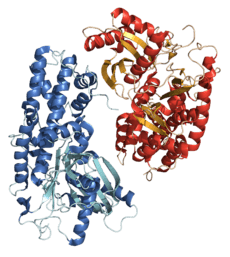Hexokinase facts for kids
A hexokinase is a special kind of enzyme. Think of enzymes as tiny helpers in your body. Hexokinases help by adding a small chemical group called a "phosphate" to sugars that have six carbon atoms. These sugars are called "hexoses."
Hexokinase's main job is to take a sugar, usually glucose, and attach a phosphate to it. This phosphate often comes from a molecule called ATP. ATP is like the energy currency of your cells.
When hexokinase adds a phosphate to glucose, it creates a new molecule called glucose-6-phosphate. This step is super important for how your body uses sugar for energy.
Contents
How Hexokinase Works

Hexokinase acts on a "substrate," which is the molecule it works on. For hexokinase, the main substrate is glucose. It takes this glucose and adds a phosphate group to it. This phosphate usually comes from ATP, which provides the energy for this chemical reaction.
The new molecule formed is called a "product." When glucose is the substrate, the product is glucose-6-phosphate. This reaction is one of the very first steps in a process called Glycolysis. Glycolysis is how cells break down sugar to get energy.
Why Adding a Phosphate is Important
Adding a phosphate to glucose changes it in a big way. Once glucose becomes glucose-6-phosphate, it can't easily leave the cell. This is important because it traps the sugar inside. The cell can then use this trapped sugar for different things.
One main use is to make energy. The cell can continue to break down glucose-6-phosphate to create ATP. ATP is the power source for almost everything your cells do.
Another use is to store energy. The cell can turn glucose-6-phosphate into glycogen. Glycogen is like a stored form of sugar that your body can use later when it needs energy.
Where is Hexokinase Found?
Hexokinase is found in almost all living things. This includes humans, animals, plants, and even tiny yeast cells. It's a very old and important enzyme in the history of life.
Different types of hexokinases exist. For example, in humans, there are four main types. Each type might work a little differently or be found in different parts of the body. But they all do the same basic job: adding a phosphate to a six-carbon sugar.
Images for kids
See also
 In Spanish: Hexocinasa para niños
In Spanish: Hexocinasa para niños


